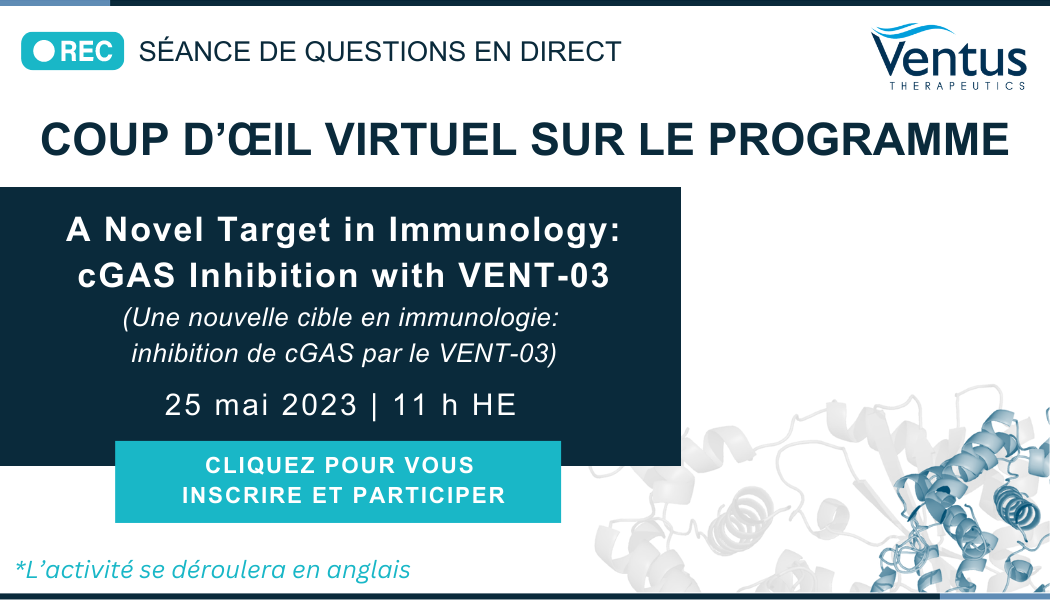The nomination of VENT-03 validates Ventus’ proprietary ReSOLVETM drug discovery platform
Phase 1 clinical trials will include patients with multiple distinct interferonopathies
Robust analyses based on internally developed and validated skin and blood biomarkers will measure inflammation and target engagement in distinct diseases, de-risking late-stage development
WALTHAM, Mass. & MONTREAL — Jan. 4, 2023 — (BUSINESS WIRE) — Ventus Therapeutics, Inc., a biopharmaceutical company utilizing structural biology and a proprietary computational chemistry platform to identify and develop differentiated small molecule therapeutics across a broad range of diseases, announced today the nomination of a potential first-in-class cGAS inhibitor, VENT-03, as the company’s first development candidate directed against cGAS. This represents the third development candidate nominated in the past 12 months to Ventus’ pipeline, following the nominations of VENT-02, a brain-penetrant NLRP3 inhibitor, and VENT-01, a peripherally restricted NLRP3 inhibitor that is partnered with Novo Nordisk.
cGAS activation leads to a type I interferon response, which is implicated in a broad range of diseases, including cutaneous lupus erythematosus, systemic lupus erythematosus, systemic sclerosis, and dermatomyositis, as well as neuroinflammatory and neurodegenerative diseases. In addition, genetic diseases, such as severe infant onset Aicardi-Goutières Syndrome and genetic forms of chilblain lupus, are driven by genetic mutations that lead to the activation of the pathway in humans. In disease-relevant preclinical studies, VENT-03 demonstrated robust in vivo pharmacodynamic activity and efficacy.
“cGAS is a highly coveted target for pro-inflammatory and neurodegenerative diseases for which no inhibitor has advanced into clinical development to date, despite significant efforts from the drug discovery industry over the past decade,” said Ventus’ President and CEO Marcelo Bigal, M.D., Ph.D. “We expect VENT-03 to be the first cGAS inhibitor to enter the clinic, with a clinical development plan tailored to provide multiple data readouts prior to Phase 2 trials.”
In December 2022, Ventus scientists published a state-of-the-art review on the industry’s progress to develop inhibitors in the cGAS-STING pathway. In May 2022, Ventus announced that it had been awarded a Lupus Research Program Idea Award from the U.S. Department of Defense, and, along with it, a multi-year grant to study the role of cGAS in lupus and the potential for treatment of the disease using a cGAS inhibitor.
“The nomination of VENT-03 as our first development candidate targeting cGAS was made possible by the unique insights provided by ReSOLVE, our proprietary drug discovery platform,” said Ventus’ Chief Scientific Officer Michael Crackower, Ph.D. “After identifying a high-resolution co-crystal structure of cGAS that was different from what had been previously published, we used ReSOLVE to determine characteristics of the binding pocket that are unique to only some of the target’s many conformations, a major breakthrough that transformed our ability to achieve high potency in our cGAS inhibitors. Given the highly validated role of the cGAS pathway as a driver of disease, we are now developing additional cGAS inhibitors to achieve the full potential of this attractive target in distinct therapeutic areas.”
About cGAS
cGAS is an intracellular pattern recognition receptor that is activated after binding to double-stranded DNA (dsDNA) in the cytoplasm. dsDNA in the cytoplasm is generally associated with cellular dysfunction, as seen in multiple diseases such as cutaneous lupus erythematosus (CLE), systemic lupus erythematosus (SLE) and dermatomyositis (DM). cGAS activation leads to cGAMP formation, activation of STING and downstream expression of type I interferons such as IFN-α, -ß and -κ, leading to pronounced inflammation and tissue damage. This pathway also leads to the expression of several other proinflammatory cytokines such as CXCL10. Genetic mutations that lead to the aberrant activation of cGAS/STING in humans are known to cause severe infant onset Aicardi-Goutières Syndrome (AGS) and genetic forms of chilblain lupus, demonstrating the relevance of the pathway in human diseases. Given that the pathophysiology and presentation of these genetic diseases have significant similarities with idiopathic complex diseases such as CLE, SLE and DM, these diseases represent highly compelling opportunities for treatment with a cGAS inhibitor.
About Ventus Therapeutics
Ventus Therapeutics is a biopharmaceutical company deploying leading-edge structural biology and computational chemistry tools to create novel small molecule medicines for challenging targets, with an initial focus on immunology, inflammation and neurology. The Company’s proprietary drug discovery platform ReSOLVE gives it the ability to discover and develop medicines through unique insights into protein targets and to create dynamic blueprints that can guide the development of differentiated small molecule medicines. The Company’s lead programs target key innate immune modulators, including NLRP3 and cGAS. The Company is using its ReSOLVE platform to improve the way medicines are discovered and developed, with the ultimate goal of restoring the health of people facing serious illnesses. For more information, please visit www.ventustx.com and engage with Ventus on LinkedIn.
Forward-Looking Statements
This press release contains forward-looking statements about future expectations, plans and prospects, including, but not limited to, statements related to the anticipated benefits of the executive leadership team, Ventus’ business strategy, current programs, future results of operations, and financial position. These forward-looking statements are based on the Company’s current expectations and inherently involve significant risks and uncertainties. Actual results and the timing of events could differ materially from those anticipated in such forward-looking statements as a result of these risks and uncertainties, which include, without limitation, the timing, progress, and results of preclinical and clinical studies involving its development programs; the results of its earlier studies not being predictive of future results; its ability to enhance the ReSOLVE platform; its ability to continue to obtain funding for its operations and to implement its business strategy; the impact of the COVID-19 pandemic on its business and its efforts to address the impact on its business; anticipated developments related to its competitors and its industry; the performance of third-party service providers, including suppliers and manufacturers; and its ability to obtain, maintain, and protect its intellectual property. Any forward-looking statements contained in this press release speak only as of the date hereof, and Ventus undertakes no duty or obligation to update any forward-looking statements as a result of new information, future events, or otherwise.
Media Contact
Kyle Evans
ICR Westwicke
646-277-1295
Kyle.evans@westwicke.com


